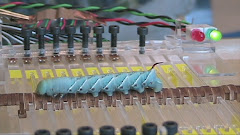Some people asked me how I got into rolling locomotion from soft-bodied animals. This is actually a subtle point which perhaps I didn't make it explicit in my previous post. Although my current study system is one without any well-defined articulation, my interest is really about morphologies that function through morphing. All animals in the wild have to undergo dramatic transformation to switch the mode of locomotion (e.g. from crawling, swimming, running or whatever to wheeling/rolling). Their bodies are definitely morphing morphologies.
Similarly, soft-bodied robot can be defined by its ability to morph regardless of its material. Indeed, the definition of "soft-bodied robot" has been a indefinite argument in my research group. What is really considered "soft"? Isn't it all relative?
After four years of contemplation, I have only recently come to the conclusion that a soft-bodied robot is a robotic device that can conform to the environment without active control. In other words, soft-bodied robots do not maintain any definite posture. Instead they allow the environment to determine its shape in conjunction with the internal control of body properties. This definition was really an inspiration from my study of caterpillar locomotion. Proprioception (perception of body posture) is therefore insignificant by definition. If we translate this definition of soft-bodiedness back to the animal kingdom. A true soft-body is one that does not force any posture. This will exclude all the hydrostatically controlled bodies especially muscular hydrostats. How heretic? Octopus arms are not soft? Well, we must also recognize that tissues can be tuned to different states. An octopus arm can be a very well-controlled muscular hydrostat when performing a manipulative task but highly compliant when relaxed. From this concept, I urge the biology community to take on more specific terms when describing animals or organismic bodies:
Articulated body [lever-linkage system with joint actuation]
Celumic hydrostat [the pressurized fluid-filled body as a skeleton]
Muscular hydrostat [muscles as the skeleton and actuators]
Environmental skeleton [substrate as skeleton on which muscles act]
Subscribe to:
Post Comments (Atom)

.jpg)
No comments:
Post a Comment